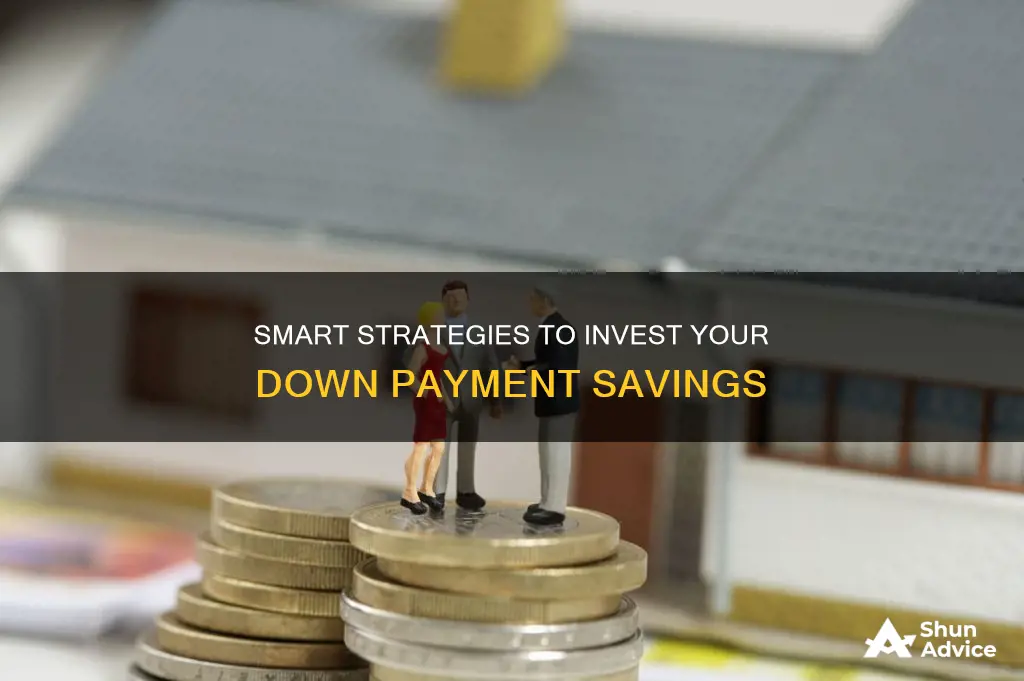
Saving for a down payment on a house can be challenging, especially in the current economic climate. The good news is that there are several options for how to invest your down payment savings. Here are some tips to help you get started:
- Set a savings goal: Determine how much money you will need for a down payment by considering the purchase price, lender requirements, and mortgage insurance.
- Include closing costs: Factor in closing costs, which can add up to 2-5% of your home's value, into your calculations.
- Choose the right account: Keep your down payment savings in a high-yield savings account or explore other risk-free investments like certificates of deposit (CDs).
- Set a deadline: Decide when you plan to purchase your home and calculate how much you need to save each month to reach your goal.
- Prioritize saving: Create a budget that treats your savings goal as a must-pay bill and cut back on discretionary spending if needed.
- Automate your contributions: Set up automatic contributions to your savings account on payday to make sure you stay on track.
- Keep track of your progress: Monitor your savings regularly to ensure you're on target and make adjustments if necessary.
What You'll Learn

Save in a high-yield savings account
Saving in a high-yield savings account is a great option for those who want to earn a competitive annual percentage yield (APY) on their money without locking it in for a fixed period. This is a good option for those who are saving for a down payment on a house and are unsure of the time horizon for the money.
High-yield savings accounts are federally insured for up to $250,000 and offer a safe place to put your money while earning interest. The national average APY is 0.6%, but some high-yield savings accounts are currently paying between 4% and 5.5% APY.
- Shop around for the best rates: Compare the APY, minimum opening deposit and minimum balance requirements, and monthly fees charged by different banks.
- Look for accounts with no monthly fees: Some high-yield savings accounts charge monthly maintenance fees, so make sure you know what these are and how to avoid them (e.g. by keeping your balance above the minimum threshold).
- Check how you can access your money: Some accounts may offer an ATM card, while others may only allow you to withdraw money by transferring it to a linked account.
- Consider the interest-compounding method: Banks can compound interest daily, monthly, quarterly, semi-annually or annually. More frequent compounding will increase your yield.
- Watch out for excess transaction fees: Most banks limit the number of withdrawals you can make each month, and you may be charged a fee for exceeding this limit.
Retirement Reinvented: Exploring Post-Retirement Investment Strategies for $30,000
You may want to see also

Automate your savings
Automating your savings is a great way to build your savings without having to remember to transfer money manually and avoid the temptation to spend it. Here are some ways to automate your savings:
Choose Your Method of Funds Transfer
You can set up automatic transfers from your checking account to your savings account. Many banks allow customers to set up recurring transfers where you choose the amount and the date—often weekly or monthly—to automatically move money. You can also set up electronic notifications of your account balance and scheduled payments to monitor your finances. It is important to be aware of your monthly income and expenses to avoid overdraft fees.
Direct Deposit
If your employer offers direct deposit, you can arrange to have a portion of your paycheck automatically deposited into your savings account. This ensures that money is put aside for savings goals and can be beneficial if you are prone to spending most of your paycheck before your next payday.
Use Automatic Savings Tools
There are various apps available, such as Acorns, Stash, and Digit (now Oportun), that can help you save automatically. These apps can round up your purchases to the nearest dollar and transfer the spare change to your savings account. They also offer features like savings goals, budgeting tools, and investment options.
Enroll in a 401(k)
If you have access to a traditional 401(k) plan through your employer, consider enrolling. This is a tax-advantaged retirement plan where a portion of your pre-tax paycheck is sent to a retirement account, and some employers will even match your contributions up to a certain percentage.
Choose a High-Interest Savings Account
To maximize your savings, consider choosing a high-interest savings account, which can offer rates that are much higher than the national average. Online banks often provide more attractive interest rates than traditional banks. Additionally, look for accounts with no monthly fees or minimum balance requirements.
By utilizing these methods, you can make saving for your down payment more manageable and increase your chances of reaching your financial goals.
Young Investors: Who and How Many?
You may want to see also

Cut unnecessary spending
Cutting unnecessary spending is a great way to save money for a down payment. Here are some tips to help you cut down on your expenses:
- Keep track of your spending habits: Start by recording all your expenses, no matter how small, for at least a month. This will help you identify areas where you can cut back.
- Update subscriptions: Evaluate your subscriptions and cancel any that you don't use regularly or are unnecessary. This includes streaming services, gym memberships, and other monthly services.
- Reduce utility costs: Make simple changes like switching to LED light bulbs, adjusting your thermostat, and unplugging unused electrical devices to save on energy costs.
- Choose cheaper housing options: Consider moving to a less expensive area, getting a roommate, or renting instead of buying to reduce your housing costs.
- Consolidate debts: Combine multiple debts into a single loan with a lower interest rate to lower your monthly payments and pay off your debt faster.
- Shop for cheaper insurance: Compare rates from different insurance companies and consider raising your deductible to reduce your insurance premiums.
- Reduce dining out expenses: Cooking at home and packing meals can significantly reduce your food expenses. Plan your meals, shop with a list, and take advantage of coupons and discounts to save on groceries.
- Switch to cash payments: Using cash instead of credit cards can help you be more mindful of your spending and reduce impulse purchases.
- Pay off debts: Focus on paying off high-interest credit card debt first to free up more money in your budget.
Mexico's Investment Magnet: Exploring the Country's Attractiveness for Global Capital
You may want to see also

Explore additional sources of income
If you have the time and energy, another source of income can help you save for a down payment. This could mean taking up a side hustle like freelancing, pet sitting, babysitting, or working for a gig app company such as Uber, Instacart, or Doordash. You might even be able to turn a hobby into a way to make money.
- Getting a promotion at your job
- Changing jobs for a higher-paying position
- Starting a small business
- Selling items around the house for extra money
- Looking for passive income opportunities
- Adjusting your income tax withholding
You can also cut back on expenses to increase your savings:
- Dining out, entertainment, and travel
- Calling providers for customer retention discounts on services like insurance, cable, cellphone, internet, security monitoring, pest control, and lawn care
- Recurring subscriptions
Will Bernstein's Timeless Investing Wisdom
You may want to see also

Look for down payment assistance programs
If you are a first-time homebuyer, you may be eligible for down payment assistance from a government agency or private organisation. In the US, there are more than 2,000 down payment assistance programs (DPAs) available, many of which are run by state, county, and city governments.
DPAs can come in the form of grants, loans, or other programs. The most valuable form of assistance is a grant, as this is a gift that does not need to be repaid. However, some grants may create a second lien on your home, so it is important to carefully read the terms and conditions of any agreement. Forgivable loans are another option, which are second mortgages that do not need to be paid back as long as you stay in the home for a set number of years. Deferred-payment loans are also available, which are typically repaid when you move, sell, or refinance your home.
To be eligible for down payment assistance, you will usually need to meet certain criteria, such as being a first-time homebuyer, having a low- to moderate-income, and buying a primary residence. In addition, many programs require you to attend a class on homebuying and finances, and some may also have location-specific requirements.
To find out what assistance is available in your area, you can search online for "down payment assistance grants in [state, county, or city]". You can also contact your local housing authority or a nonprofit organisation that provides homebuyer education and financial planning. When applying for assistance, be sure to check that the program is acceptable to your lender.
Retirement Investments: Safe Options for the Elderly
You may want to see also
Frequently asked questions
The old standard for a down payment is 20% of the home price, but nowadays it's become more common to put down less. The minimum down payment depends on the type of mortgage you get. For example, conventional loans can require as little as 3% of the purchase price, while FHA loans require a minimum of 3.5%.
It's generally recommended to keep your down payment savings in a safe, easily accessible account like a high-yield savings account or money market account. This ensures that your savings are protected and readily available when you need them.
The time it takes to save for a down payment depends on how much money you need to put down and how much you can set aside each month. It's important to consider your location and timing, as these factors can impact the amount you need to save.
Yes, there are several other costs to consider when budgeting for a home purchase. These include closing costs, mortgage reserves, maintenance and repair expenses, moving expenses, and an emergency fund.
Here are some strategies to help you save for a down payment: automate your savings by setting up regular contributions, reduce expenses, explore additional sources of income, and look for down payment assistance programs.







